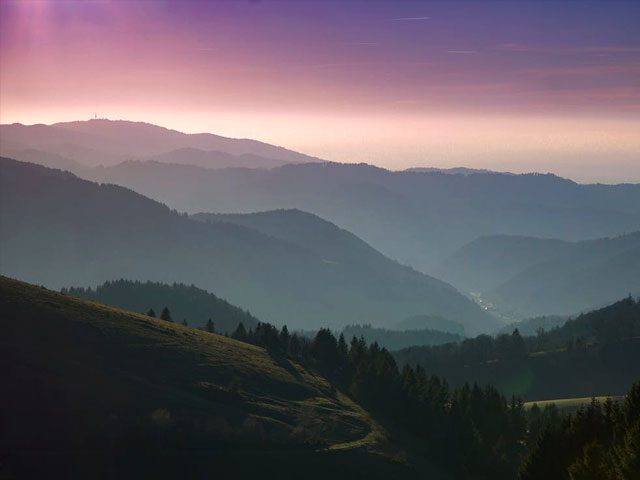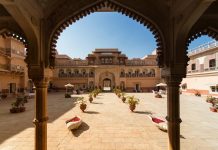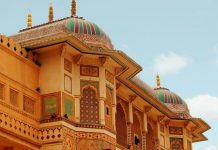Winters are receding in even the cold parts of India and it is almost time to make the best of the time by giving the season a grand send off. Choose a few hilly destinations within India that can give any Alps a trek for its height. Here are our recommendations:
1. Mukteshwar, Uttarakhand

Image Credit : flickr.com
Nestled in the Nainital district in the state of Uttarakhand, Mukteshwar is a hilly region comprising of beautiful fruit orchards and fairytale coniferous forests. Deriving its name from the name of Lord Shiva, it is a beautiful tourist destination situated at a height of 7500 feet above the sea level in the Kumaon hills.
Mukteshwar is about two hours’ drive from Nainital – but far less crowded than its more popular hilly sister. It is even more beautiful, though. It is sleepy, small and quiet – the kind of place you head to when you don’t particularly want places of interest that would be marked in any travel book. It’s where you should go when you just need a break from the fast pace of life and find yourself again. Mukteshwar, famous for the famous man eating tiger, shot by the legendary Jim Corbett, is away from the hustle and bustle of the city life.
A perfect place to find apple orchards, pine forests, wild flowers and tiny temples that would soak all your exhaustion. Talking of temples, do visit the ancient Shiva temple here. Besides this, Chauli ki Jali in Mukteshwar is popular for rock climbing. At Chauli ki jali, travelers enjoy the beautiful scenery. It is an ideal place to observe eagles and other raptors. Methodist Church, that has a tin roof and painted walls is also worth going to – simply to admire the simplicity of the area. Mukteshwar is rich in scenic beauty, with magnificent views of many Himalayan peaks, including India’s second-highest peak, Nanda Devi. For people who are seeking retreat from the heat of the cities, Mukteshwar appears to be the best pick.
2. Coonoor, Tamil Nadu

Image Credit :pexels.com
If you have nothing to do, Coonoor is the perfect place to do it in. Coonoor is the second-highest hill station in the Nilgiri region, after Ooty. It is famous because of its serene beauty. Known for production of Nilgiri tea, it’s also ideal as a base camp for treks that lead into the Nilgiris. The Badagas, a warrior community that shares its lineage with the Kodagas of Coorg, sought refuge in the Nilgiris during the reign of Tipu Sultan and it is to them that the culture and heritage of this quaint tea producing town owes its preservation.
Based out of Coonoor, you can do pretty much the same stuff that Ooty offers – just that Coonoor has the peace and quiet that tourist-crowded Ooty does not. But do avoid central Coonoor, which is busy and bustling. Treks, forest walks, and tea garden visits are a must. There are several trekking routes that lead out of town – good fun in themselves that also lead to dramatic viewpoints of the Nilgiris, and the tea and coffee plantations.
Sim’s Park, a beautifully manicured botanical garden, is also worth a visit. You can also arrange to check out the tea-making processes at a factory or hop across to the pretty Law’s Falls nearby. Trek onto Droog from the falls and explore the ruins of a 16th century fort. Do sample local Badaga cuisine such as soppu (a tasty curry made of local greens), batthal (yummy sun-dried potato wafers) and ottukudi (the incomparable tender bamboo shoots).
3. Chikhaldara, Maharashtra

Image Credit :flickr.com
Chikhaldara in Maharashtra is about 100 kilometres from Amravati and 750 kilometres from Mumbai. It is a very pretty and practically unexplored, totally anonymous hill station. The Keechakdhara lake has a mythological significance. It is named after Keechaka, the villain in Mahabharata who made lustful advances towards Draupadi – and the place where Bheem threw his body after killing him became Keechakdhara. The Bheem Kund is where the mighty Pandava washed Keechaka’s blood off his hands. Chikhaldara has the added distinction of being the only coffee-growing region in Maharashtra. Dotted with deep valleys, the myriad shades of green that nature has painted Chikhaldara are simply unbelievable.
At a height of 1,088 meters above sea level, Chikhaldara is surrounded on three sides by the borders of the Melghat Project Tiger Area which is spread over an area of about 1,676 square kilometers. The Gawilgadh Fort, the temples around, the wildlife museum and of course, the view points. There’s also a tiger sanctuary. According to the last count, the tiger reserve has over 70 tigers along with almost the same number of leopards. It also has about 200 sloth bears, 1,800 Indian gaurs and hundreds of herbivore animals like Cheetal, Sambar, Barking Deer, Wild Boar, Choushinga, etc. The reserve also has rare animals like the Flying Squirrel, Pangolin, Mouse Deer, Ratel and Honey Badger.
The Gawilgadh Fort, that features prominently in the second Anglo-Maratha war, and was a well-fortified mountain stronghold of the Maratha Empire, is worth a visit too.
4. Tawang, Arunachal Pradesh

Image Credit :flickr.com
Vishal Bharadwaj shot his period drama Rangoon in the unseen views of Tawang – about 500 km from Guwahati and still one of the few hidden nooks in the hills of Eastern Himalayas. It’s incredibly beautiful. Though one of the most visited hill stations in Arunachal Pradesh, Tawang is still relatively unpopular with the regular tourist crowd. At an altitude of over 10,000 feet, Tawang never tires of being described as tranquil and serene, along with other words that describe a place of extreme natural beauty.
Shonga-Tser Lake, formed by an earthquake is one of the more remarkable places you can visit here. Pangang Teng Tso is another lake that will capture your imagination. These are lakes in the Himalayas – they are pristine, with water so clear that you can see the reflections of mountains and trees in them. With Tibet on one side and Bhutan on another, Tawang presents a beautiful Buddhist dominated cultural mix. The main attraction here is the Tawang monastery, said to be the biggest Buddhist monastery in the world outside of Lhasa. This is als, where the sixth Dalai Lama was born. Set a day aside to visit the Jang Falls, too. Get the Inner Line Permit from Delhi, Guwahati or Kolkata.
Visitors to this quiet hill station can keep themselves busy rock climbing, paragliding and river rafting. There’s a ski lift in town for the months of December and January when it snows. But if you really want to take advantage of the place, sit back and enjoy the view – never-ending stretches of little flowers growing on a mountainous land, monks in orange robes going along their slow-paced life and nature bowling you over with its beauty!
For those that are dreading the sweltering heat of the plains, and want to pack their bags and head to the cooler climes of higher altitudes, a vacation away from the madding crowd – where there is only solitude, peace, nature and you – is a great idea!














